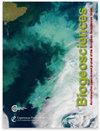Identifying landscape hot and cold spots of soil greenhouse gas fluxes by combining field measurements and remote sensing data
IF 3.9
2区 地球科学
Q1 ECOLOGY
引用次数: 0
Abstract
Abstract. Upscaling chamber measurements of soil greenhouse gas (GHG) fluxes from point scale to landscape scale remain challenging due to the high variability in the fluxes in space and time. This study measured GHG fluxes and soil parameters at selected point locations (n=268), thereby implementing a stratified sampling approach on a mixed-land-use landscape (∼5.8 km2). Based on these field-based measurements and remotely sensed data on landscape and vegetation properties, we used random forest (RF) models to predict GHG fluxes at a landscape scale (1 m resolution) in summer and autumn. The RF models, combining field-measured soil parameters and remotely sensed data, outperformed those with field-measured predictors or remotely sensed data alone. Available satellite data products from Sentinel-2 on vegetation cover and water content played a more significant role than those attributes derived from a digital elevation model, possibly due to their ability to capture both spatial and seasonal changes in the ecosystem parameters within the landscape. Similar seasonal patterns of higher soil/ecosystem respiration (SR/ER–CO2) and nitrous oxide (N2O) fluxes in summer and higher methane (CH4) uptake in autumn were observed in both the measured and predicted landscape fluxes. Based on the upscaled fluxes, we also assessed the contribution of hot spots to the total landscape fluxes. The identified emission hot spots occupied a small landscape area (7 % to 16 %) but accounted for up to 42 % of the landscape GHG fluxes. Our study showed that combining remotely sensed data with chamber measurements and soil properties is a promising approach for identifying spatial patterns and hot spots of GHG fluxes across heterogeneous landscapes. Such information may be used to inform targeted mitigation strategies at the landscape scale.结合实地测量和遥感数据确定土壤温室气体通量的景观热点和冷点
摘要。由于土壤温室气体通量在空间和时间上的高变异性,从点尺度到景观尺度的土壤温室气体通量室测量结果的放大仍具有挑战性。本研究测量了选定点位(n=268)的温室气体通量和土壤参数,从而在混合土地利用景观(∼5.8 平方公里)上实施了分层取样方法。根据这些实地测量数据以及景观和植被特性遥感数据,我们使用随机森林(RF)模型预测了夏秋季景观尺度(1 米分辨率)的温室气体通量。结合实地测量的土壤参数和遥感数据的随机森林模型优于仅使用实地测量的预测因子或遥感数据的模型。与数字高程模型得出的属性相比,"哨兵-2 "号卫星上关于植被覆盖和含水量的现有卫星数据产品发挥了更重要的作用,这可能是由于它们能够捕捉景观中生态系统参数的空间和季节变化。在测量和预测的景观通量中都观察到了类似的季节性模式,即夏季土壤/生态系统呼吸作用(SR/ER-CO2)和氧化亚氮(N2O)通量较高,秋季甲烷(CH4)吸收量较高。根据放大的通量,我们还评估了热点地区对总景观通量的贡献。已确定的排放热点所占景观面积很小(7% 到 16%),但却占景观温室气体通量的 42%。我们的研究表明,将遥感数据与室内测量结果和土壤特性相结合,是一种很有前途的方法,可用于识别异质景观中温室气体通量的空间模式和热点。这些信息可用于在景观尺度上制定有针对性的减缓战略。
本文章由计算机程序翻译,如有差异,请以英文原文为准。
求助全文
约1分钟内获得全文
求助全文
来源期刊

Biogeosciences
环境科学-地球科学综合
CiteScore
8.60
自引率
8.20%
发文量
258
审稿时长
4.2 months
期刊介绍:
Biogeosciences (BG) is an international scientific journal dedicated to the publication and discussion of research articles, short communications and review papers on all aspects of the interactions between the biological, chemical and physical processes in terrestrial or extraterrestrial life with the geosphere, hydrosphere and atmosphere. The objective of the journal is to cut across the boundaries of established sciences and achieve an interdisciplinary view of these interactions. Experimental, conceptual and modelling approaches are welcome.
 求助内容:
求助内容: 应助结果提醒方式:
应助结果提醒方式:


